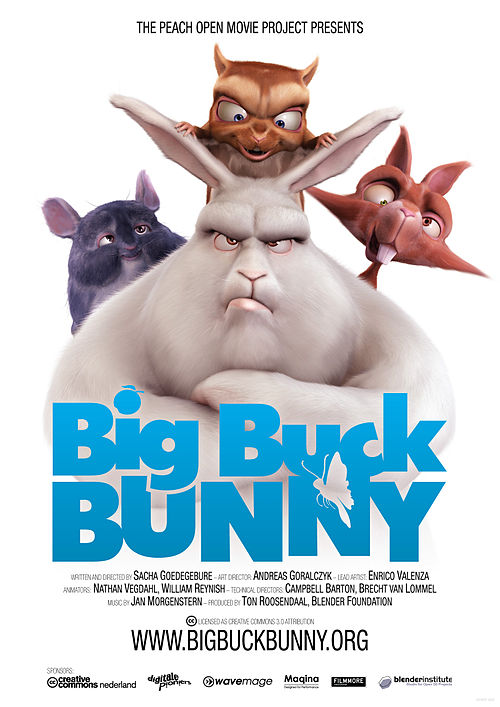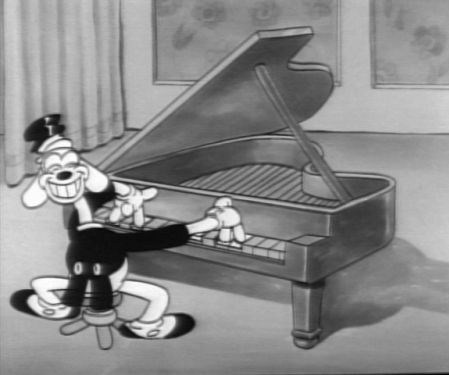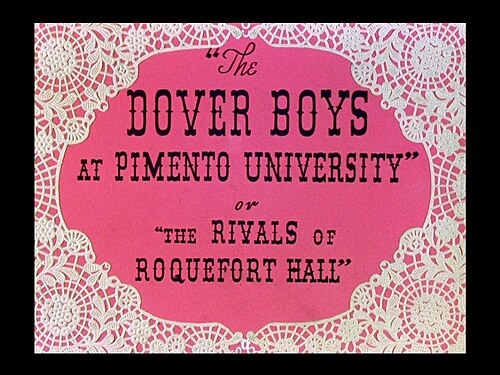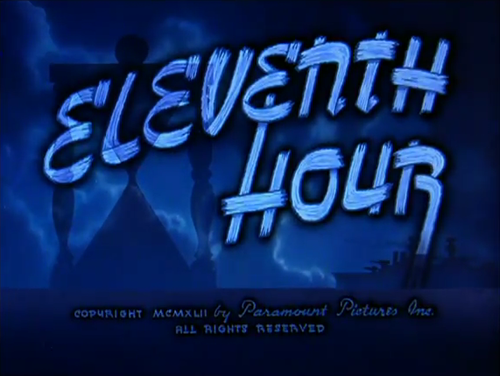Advertisement

Image source: Wikimedia Foundation (wikimedia.org)
Download Movie [Video Format: MP4]
Movie Source: Internet Archive (archive.org)
Advertisement
Advertisement
Merrie Melodies - A Corny Concerto
1943
A Corny Concerto is an American animated collection of two musical segments produced by Leon Schlesinger Productions and distributed by Warner Bros. It was directed by Bob Clampett, written by Frank Tashlin, animated by Robert McKimson and released as part of the Merrie Melodies series on September 18, 1943. A parody of Disney's 1940 feature Fantasia, the film uses two of Johann Strauss' best known waltzes, Tales from the Vienna Woods and The Blue Danube, adapted by the cartoon unit's music director, Carl Stalling and orchestrated by its arranger and later, Stalling's successor, Milt Franklyn. Long considered a classic for its sly humor and impeccable timing with the music, it was voted # 47 of the 50 Greatest Cartoons of all time by members of the animation field in 1994. The title, in tune with the name of the unit's other cartoon series, Looney Tunes, suggests another Disney titling parody, that of the pioneering series Silly Symphonies.
This was the first WB cartoon ever to feature more than two of their major characters in starring roles (though not all appeared on screen at the same time). Elmer Fudd appears as the musicologist/composer (as Deems Taylor was in Fantasia) introducing each segment. The first segment, Tales from the Vienna Woods, stars Bugs Bunny and Porky Pig, the former as the prey and the latter (in his first color cartoon) as the hunter. This is one of only two cartoons in which both Bugs and Porky appear (the other, Dumb Patrol (1964) features Porky only briefly). In addition, a number of people consider the main character in the second segment, The Blue Danube, to be a "baby" version of Daffy Duck. This is also the second time the Warner Bros. studio had lampooned Fantasia; Pigs in a Polka from 1942 had given a similar treatment to the works of Johannes Brahms, with the Three Little Pigs as the stars.
The film's name is explained in the first shot as Carnegie Hall, here called "Corny-gie Hall", becomes the setting for the stately appearance of a distinguished musicologist, most notably exemplified by Deems Taylor, who introduced Fantasia. Pyotr Tchaikovsky's Piano Concerto No. 1 is heard over the opening credits. The "eminent personality" here, presented in the same grandiose fashion as Taylor, turns out to be none other than Elmer Fudd (voiced by Arthur Q. Bryan) who, while wearing Deems Taylor-style eyeglasses, although notably oversized, exhibits all of his own familiar mannerisms, including the nervous giggle and characteristic rhotacism: "And as we hear the rhythmic strains of the haunting rain, listen to the ripping rhythm of the woodwinds, as it rolls around and around, and it comes out here..."(quoting the lyrics to the popular song The Music Goes Round and Round). In a staple of cartoon humor, Elmer is unable to control his starched tuxedo shirt front, which keeps rolling up in the manner of a window shade into his face while he tries to introduce the Vienna Woods segment. He finally rips it away with one last giggle before the first segment. Returning for the introduction of the slightly-longer Blue Danube segment, he holds the ripped away tuxedo shirt front in place to cover himself in front, until he waves his arms to introduce the Blue Danube, causing his trousers to fall down and eliciting a final giggle of embarrassment. The two introductions contain the only spoken words in the cartoon since, apart from a few isolated non-verbal vocal sounds and sound effects, the soundtrack of the musical segments consists of the Strauss waltzes.
Tales from the Vienna Woods
In tune with the rhythm of Strauss' waltz, Porky Pig and his unnamed hunting dog are in the presumed woods of the title, as Porky, in the role usually reserved for Elmer Fudd's rabbit/duck hunter character, holds up the sign "I'm hunting that @!!*@ rabbit!!" (which turns out to be none other than Bugs Bunny) and the dog holds a sign of his own which simply states "DITTO". Other than the 1930s incarnation of Porky hunting a Bugs Bunny prototype in Ben "Bugs" Hardaway's and Cal Dalton's Porky's Hare Hunt (1938), this is Porky's sole outing as a "rabbit hunter", but since both Porky and Bugs are also bet here of their familiar voices, the primary motivator of the plot becomes the expressiveness of the characters' "balletic performance". The "@!!*@ rabbit", to the beat of the music, chomps on his carrots, lifting his foot out of the hole to press the pedal to open the lid of his "Rabbit Rubbish" receptacle, tossing carrot stubs in and closing the lid. This alerts Porky's dog, who points to Bugs' hiding hole. Bugs' hands emerge from the hole, holding a book entitled Emily Post Etiquette, then turns to a page that states "It ain't polite to point!" at which he then slams the book shut on the spherical nose at the tip of the dog's snout. Bugs then emerges from his hole, standing on a theater-style elevated platform, pirouettes out like a ballerina, dance kicks the dog in the face and ties his tail to a tree, making the dog spring back and crash into the flimsy stump, breaking it over his head which knocks him senseless and causes him to burble his lips with his finger like a baby.
Porky and the dog hide in a bush, only to find Bugs already there. Bugs confuses the duo and makes the dog jump in the bush, then runs out and pretends to be the dog, pointing to the bush. The dog pops out just before Porky pulls the trigger, followed by Bugs' grabbing the shotgun and throwing it into a tree's knothole, where a squirrel, irked by the entry of the object into his abode, fires the weapon. The impact of the gunshot causes each main character to assume his own fatal wounding. As Porky and the dog examine themselves and find no bullet mark, Bugs, appearing to be mortally hit, falls to the ground. Porky and the dog start mourning him, with the dog preparing a first aid kit while Porky tries to undo Bugs' fingers around his chest. However, once he does so, Bugs is revealed to have a baby blue bra underneath. Emitting a scream of feminine modesty, he rises as a ballerina wearing a tutu and pointe shoes that matches the same color of his bra, slapping Porky's face three times, ties them to each other with the bra, flipping his tutu to revealed his pink bloomers to the audience, and gracefully dances off into the distance, falling at the end of his dance, and leaving his two antagonists with puzzled and dismayed expressions on their faces.
The Blue Danube
Set upon a cartoon representation of the title waterway, this parody of Disney's Silly Symphony cartoon, The Ugly Duckling, is perfectly timed to the strains of the Strauss waltz. As the story opens, a mother swan is gliding with her brood, when a small black duck (which some animation historians have described as a possible representation of baby Daffy Duck, pre-dating Baby Looney Tunes by nearly 60 years) tries to join them. The mother angrily makes eyes at him and swats him away, and he swims away with a big red handprint on his backside. When the lonesome little duckling tries again, using his underwater bubble tactic, the mother becomes even angrier at the little pest, now floating encased in a big bubble, and slaps him back to the water.
A large buzzard in a "hep cat" hairdo spots the troupe using his eyes which can extend and adjust to focus like binoculars. He hangs up an "Out To Brunch" sign and swoops down for his meal. Swimming behind them to the rhythm of the music, he sprinkles salt and pepper on one of the little swans, but the pepper makes the baby swan sneeze. Then, one by one, the buzzard picks off the baby swans (the third one propelled by a tiny outboard motor). He also picks up the little black duck, but immediately puts him back, stamping the apparently unpalatable creature with, as befits a World War II cartoon, a "Rejected (unfit-for-military-service) 4F" label. The mother swan turns around and, seeing her charges gone, panics, looks all over and lifts a rock and peers underneath it only to see the little duckling, and slams it back down on him, and then falls into a faint. The duckling tries to revive her by splashing her with a bucketful of the water she's already lying in, and sees the buzzard taking the baby swans away, and becomes enraged. Suddenly turning into a super-duck-fighter-plane, briefly shown morphed into a representation of the P-40 Warhawk fighter, he takes to the sky after the buzzard in hot pursuit, zooming past a clasp of trees which suddenly become alive as they react to the passing object. The buzzard sees the enraged duckling chasing him and literally turns yellow, dropping the baby swans, each of whom opens a little parachute on the way down, allowing them to drop safely. The duckling loops around and smashes head-on into the buzzard, now seemingly a symbolic representation of our wartime enemies and, as the buzzard is knocked out, hands him a drum of TNT and drops him from the sky. The impact with the ground causes the TNT drum to explode on the buzzard who is then seen strumming on a harp and floating towards some form of afterlife, held aloft by a balloon tied to his tail.
The final scene shows the heroic black duckling, savior of the family, as part of the mother swan's brood, quacking along to the rhythm of the waltz's finalé—with only his own little lection in the water not paying attention. While the duckling himself turned off in another direction along with mother swan and her brood, his lection happily quacks along with the music swimming straight, banging into a tree, then frantically zig-zags to catch up to him as the cartoon fades out.
Analysis
Fantasia was marketed to highbrow music fans; the Looney Tunes staff responded by violating the ivory tower of classical music and concert hall culture. The short parodies both Fantasia's Silly Symphonies-derived balletic approach to storytelling. Elmer Fudd stands in for Deems Taylor and in an anti-highbrow gag, his starched shirtfront keeps erupting from his shirt to hit him on the face. This sets the stage for a comedic approach to storytelling.[1]
"A Tale of the Vienna Woods" is performed as a hunting sketch, starring Porky and Bugs.[1]
This was the first WB cartoon ever to feature more than two of their major characters in starring roles (though not all appeared on screen at the same time). Elmer Fudd appears as the musicologist/composer (as Deems Taylor was in Fantasia) introducing each segment. The first segment, Tales from the Vienna Woods, stars Bugs Bunny and Porky Pig, the former as the prey and the latter (in his first color cartoon) as the hunter. This is one of only two cartoons in which both Bugs and Porky appear (the other, Dumb Patrol (1964) features Porky only briefly). In addition, a number of people consider the main character in the second segment, The Blue Danube, to be a "baby" version of Daffy Duck. This is also the second time the Warner Bros. studio had lampooned Fantasia; Pigs in a Polka from 1942 had given a similar treatment to the works of Johannes Brahms, with the Three Little Pigs as the stars.
The film's name is explained in the first shot as Carnegie Hall, here called "Corny-gie Hall", becomes the setting for the stately appearance of a distinguished musicologist, most notably exemplified by Deems Taylor, who introduced Fantasia. Pyotr Tchaikovsky's Piano Concerto No. 1 is heard over the opening credits. The "eminent personality" here, presented in the same grandiose fashion as Taylor, turns out to be none other than Elmer Fudd (voiced by Arthur Q. Bryan) who, while wearing Deems Taylor-style eyeglasses, although notably oversized, exhibits all of his own familiar mannerisms, including the nervous giggle and characteristic rhotacism: "And as we hear the rhythmic strains of the haunting rain, listen to the ripping rhythm of the woodwinds, as it rolls around and around, and it comes out here..."(quoting the lyrics to the popular song The Music Goes Round and Round). In a staple of cartoon humor, Elmer is unable to control his starched tuxedo shirt front, which keeps rolling up in the manner of a window shade into his face while he tries to introduce the Vienna Woods segment. He finally rips it away with one last giggle before the first segment. Returning for the introduction of the slightly-longer Blue Danube segment, he holds the ripped away tuxedo shirt front in place to cover himself in front, until he waves his arms to introduce the Blue Danube, causing his trousers to fall down and eliciting a final giggle of embarrassment. The two introductions contain the only spoken words in the cartoon since, apart from a few isolated non-verbal vocal sounds and sound effects, the soundtrack of the musical segments consists of the Strauss waltzes.
Tales from the Vienna Woods
In tune with the rhythm of Strauss' waltz, Porky Pig and his unnamed hunting dog are in the presumed woods of the title, as Porky, in the role usually reserved for Elmer Fudd's rabbit/duck hunter character, holds up the sign "I'm hunting that @!!*@ rabbit!!" (which turns out to be none other than Bugs Bunny) and the dog holds a sign of his own which simply states "DITTO". Other than the 1930s incarnation of Porky hunting a Bugs Bunny prototype in Ben "Bugs" Hardaway's and Cal Dalton's Porky's Hare Hunt (1938), this is Porky's sole outing as a "rabbit hunter", but since both Porky and Bugs are also bet here of their familiar voices, the primary motivator of the plot becomes the expressiveness of the characters' "balletic performance". The "@!!*@ rabbit", to the beat of the music, chomps on his carrots, lifting his foot out of the hole to press the pedal to open the lid of his "Rabbit Rubbish" receptacle, tossing carrot stubs in and closing the lid. This alerts Porky's dog, who points to Bugs' hiding hole. Bugs' hands emerge from the hole, holding a book entitled Emily Post Etiquette, then turns to a page that states "It ain't polite to point!" at which he then slams the book shut on the spherical nose at the tip of the dog's snout. Bugs then emerges from his hole, standing on a theater-style elevated platform, pirouettes out like a ballerina, dance kicks the dog in the face and ties his tail to a tree, making the dog spring back and crash into the flimsy stump, breaking it over his head which knocks him senseless and causes him to burble his lips with his finger like a baby.
Porky and the dog hide in a bush, only to find Bugs already there. Bugs confuses the duo and makes the dog jump in the bush, then runs out and pretends to be the dog, pointing to the bush. The dog pops out just before Porky pulls the trigger, followed by Bugs' grabbing the shotgun and throwing it into a tree's knothole, where a squirrel, irked by the entry of the object into his abode, fires the weapon. The impact of the gunshot causes each main character to assume his own fatal wounding. As Porky and the dog examine themselves and find no bullet mark, Bugs, appearing to be mortally hit, falls to the ground. Porky and the dog start mourning him, with the dog preparing a first aid kit while Porky tries to undo Bugs' fingers around his chest. However, once he does so, Bugs is revealed to have a baby blue bra underneath. Emitting a scream of feminine modesty, he rises as a ballerina wearing a tutu and pointe shoes that matches the same color of his bra, slapping Porky's face three times, ties them to each other with the bra, flipping his tutu to revealed his pink bloomers to the audience, and gracefully dances off into the distance, falling at the end of his dance, and leaving his two antagonists with puzzled and dismayed expressions on their faces.
The Blue Danube
Set upon a cartoon representation of the title waterway, this parody of Disney's Silly Symphony cartoon, The Ugly Duckling, is perfectly timed to the strains of the Strauss waltz. As the story opens, a mother swan is gliding with her brood, when a small black duck (which some animation historians have described as a possible representation of baby Daffy Duck, pre-dating Baby Looney Tunes by nearly 60 years) tries to join them. The mother angrily makes eyes at him and swats him away, and he swims away with a big red handprint on his backside. When the lonesome little duckling tries again, using his underwater bubble tactic, the mother becomes even angrier at the little pest, now floating encased in a big bubble, and slaps him back to the water.
A large buzzard in a "hep cat" hairdo spots the troupe using his eyes which can extend and adjust to focus like binoculars. He hangs up an "Out To Brunch" sign and swoops down for his meal. Swimming behind them to the rhythm of the music, he sprinkles salt and pepper on one of the little swans, but the pepper makes the baby swan sneeze. Then, one by one, the buzzard picks off the baby swans (the third one propelled by a tiny outboard motor). He also picks up the little black duck, but immediately puts him back, stamping the apparently unpalatable creature with, as befits a World War II cartoon, a "Rejected (unfit-for-military-service) 4F" label. The mother swan turns around and, seeing her charges gone, panics, looks all over and lifts a rock and peers underneath it only to see the little duckling, and slams it back down on him, and then falls into a faint. The duckling tries to revive her by splashing her with a bucketful of the water she's already lying in, and sees the buzzard taking the baby swans away, and becomes enraged. Suddenly turning into a super-duck-fighter-plane, briefly shown morphed into a representation of the P-40 Warhawk fighter, he takes to the sky after the buzzard in hot pursuit, zooming past a clasp of trees which suddenly become alive as they react to the passing object. The buzzard sees the enraged duckling chasing him and literally turns yellow, dropping the baby swans, each of whom opens a little parachute on the way down, allowing them to drop safely. The duckling loops around and smashes head-on into the buzzard, now seemingly a symbolic representation of our wartime enemies and, as the buzzard is knocked out, hands him a drum of TNT and drops him from the sky. The impact with the ground causes the TNT drum to explode on the buzzard who is then seen strumming on a harp and floating towards some form of afterlife, held aloft by a balloon tied to his tail.
The final scene shows the heroic black duckling, savior of the family, as part of the mother swan's brood, quacking along to the rhythm of the waltz's finalé—with only his own little lection in the water not paying attention. While the duckling himself turned off in another direction along with mother swan and her brood, his lection happily quacks along with the music swimming straight, banging into a tree, then frantically zig-zags to catch up to him as the cartoon fades out.
Analysis
Fantasia was marketed to highbrow music fans; the Looney Tunes staff responded by violating the ivory tower of classical music and concert hall culture. The short parodies both Fantasia's Silly Symphonies-derived balletic approach to storytelling. Elmer Fudd stands in for Deems Taylor and in an anti-highbrow gag, his starched shirtfront keeps erupting from his shirt to hit him on the face. This sets the stage for a comedic approach to storytelling.[1]
"A Tale of the Vienna Woods" is performed as a hunting sketch, starring Porky and Bugs.[1]





